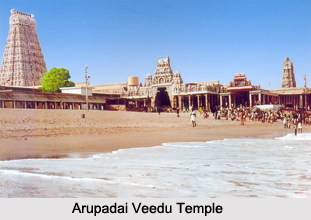 The six sacred temples of the Hindu God Lord Karthikeya - also known as Muruga, Shanmuga, Guhan, Skanda, Subramanya and Kumara are located in South India - in the state of Tamil Nadu. Though there are thousands of temples for Lord Muruga around the globe, these six specific temples enjoy unparallel sanctity and popularity among the devotees of Muruga or Balasubrahmanya - and deserve a very special mention. The origin of these temples goes back by more than 2000 years. Ancient Tamil literary works (Thirumurugatrupadai) hail these six temples and the poems authenticate their antiquity and sacredness.
The six sacred temples of the Hindu God Lord Karthikeya - also known as Muruga, Shanmuga, Guhan, Skanda, Subramanya and Kumara are located in South India - in the state of Tamil Nadu. Though there are thousands of temples for Lord Muruga around the globe, these six specific temples enjoy unparallel sanctity and popularity among the devotees of Muruga or Balasubrahmanya - and deserve a very special mention. The origin of these temples goes back by more than 2000 years. Ancient Tamil literary works (Thirumurugatrupadai) hail these six temples and the poems authenticate their antiquity and sacredness.
Thiruparankunram Subramanya Swami Temple
The first and foremost temple of Lord Muruga in India is Thiruparamkundram or Paramkundru, situated on a hill near Madurai, in Tamil Nadu, South India. Saint and poets of those called it the first place amongst the six battle places that Lord Muruga has fought to win over evil. Apart from this some poets says, it is around 2000 years ago this temple is declared a holy spot.
Thiruchendur Sendhil Andavar Temple
Thiruchendur or Thirucheer alaivai, a holy place near Tirunelveli, in Tamil Nadu houses one of the most sacred temples of Lord Muruga and is the second Aarupadai Veedu. Saint and poets in their writings sing praises about the Lord and say that this is the second place among the six battles places of Lord Muruga. This Temple is the only shrine located on the seashore.
Palani Dandayudhapani Swamy Temple
A holy place in Madurai in Tamil Nadu, Palani or Pazhani, houses one of the most sacred temples of Lord Muruga and is the third place among the battle places.. Palani Andavar is also worshipped by other names such as Dandayudhapani Swami, Kulandaivelan, Bala-subrahmanyan, Shanmukhan and Devasenapari. The temple is itself commonly known by several other names such as Tiru Avinangudi, Vayyapuri, Sithan Vazhvu, Pothini and Sivagiri.
Swamimalai Swaminatha Swami Temple
Swamimalai or Thiruveragam, a holy place near Kumbakonam, in Tamil Nadu, houses one of the most sacred temples of Lord Muruga and is the fourth battle places. Literary references to the place are also available in many other ancient Tamil scriptures and inscriptions. It is believed that Lord Muruga taught the significance of the Pranava Mantra (the sacred OM) to Lord Siva - his father - here and hence the name Swamimalai for the place and Thagappan Swami for the Lord.
Tiruthani Subramanya Swamy Temple
Tiruthani or Tiruttani, a holy place near Chennai (Madras) on the Chennai - Tirupati route, houses one of the sacred temples of Lord Muruga and is the fifth battle place. The temple is a very old one and scriptures can be used to trace the temple`s existence to as early as two thousand years ago. The temple is known by several names some of which are Kunruthor Adal, Thanigachalam, Santhipuri and Skandagiri. Lord Subramanya, it is believed, took to Tiruthani as his abode, after vanquishing the demon called Soorapadman at Tiru-chendur. At Tiruthani, the Swamy is known to be in a very tranquil state, especially after marrying Valli.
Palamudhircholai Subramanya Swamy Temple
Pazhamudir cholai or Pazhamudir solai - which was earlier known as Solai malai - is a holy place near Madurai, in Tamil Nadu. It houses one of the most sacred temples of Lord Muruga and is the sixth Aarupadai Veedu. There is a famous legend associated with the temple. It is said that Awaiyar, a famous Tamil poet and a Muruga bakthai (Muruga devotee), came here when her knowledge was put to test by Lord Muruga, taking the form of a small boy. It is firmly believed that this episode took place at a tree near the temple and the tree is worshipped even today.





















